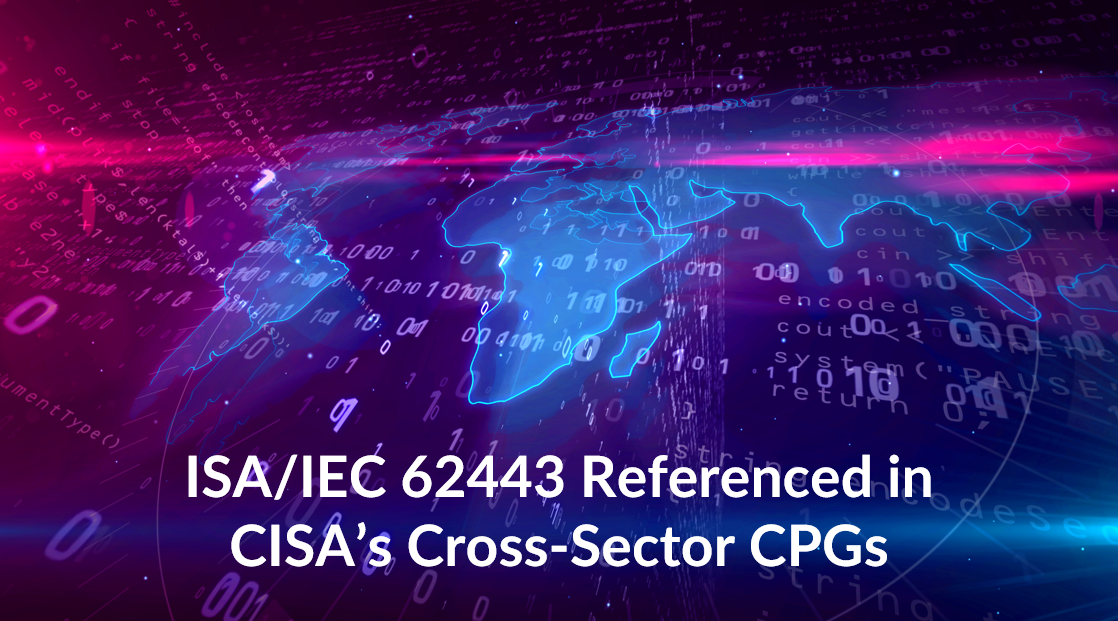“Secure Your Systems with ISA/IEC 62443: The Standard for Industrial Cybersecurity”.
Introduction
A July 2021 memorandum by President Biden required the Cybersecurity & Infrastructure Security Agency (CISA) and the National Institute of Standards and Technology (NIST) to develop voluntary cybersecurity performance goals (CPGs) across all critical infrastructure sectors. These CPGs reference and complement the NIST Cybersecurity Framework (CSF), and also extensively reference ISA/IEC 62443-2-1 and ISA/IEC 62443-3-3 in almost every category.
ISA/IEC 62443 is an international standard for industrial automation and control systems (IACS) security. It is a comprehensive set of standards and practices that provide a framework for the secure design, implementation, and maintenance of IACS. The standard was developed by the International Society of Automation (ISA) and the International Electrotechnical Commission (IEC). The standard is referenced in the Cybersecurity and Infrastructure Security Agency’s (CISA) Cross-Sector Critical Infrastructure Protection (CIP) Guidelines. The CIP Guidelines provide guidance to organizations on how to protect their critical infrastructure from cyber threats. The ISA/IEC 62443 standard is an important part of the CIP Guidelines, as it provides a comprehensive set of security requirements for IACS. This standard is essential for organizations to ensure the security of their IACS and protect their critical infrastructure from cyber threats.
How ISA/IEC 62443 Can Help Organizations Meet CISA’s Cross-Sector Cybersecurity Guidelines
The Cybersecurity and Infrastructure Security Agency (CISA) has developed a set of cross-sector cybersecurity guidelines to help organizations protect their networks and data from cyber threats. The International Society of Automation (ISA) and the International Electrotechnical Commission (IEC) have developed the ISA/IEC 62443 series of standards to help organizations meet these guidelines.
The ISA/IEC 62443 series of standards provides a comprehensive set of requirements for industrial automation and control systems (IACS) security. The standards cover a wide range of topics, including system architecture, secure development, secure configuration, secure operation, and secure maintenance. The standards also provide guidance on how to assess the security of IACS and how to respond to security incidents.
The ISA/IEC 62443 series of standards can help organizations meet CISA’s cross-sector cybersecurity guidelines in several ways. First, the standards provide a comprehensive set of requirements for IACS security, which can help organizations identify and address potential security vulnerabilities. Second, the standards provide guidance on how to assess the security of IACS, which can help organizations identify and address potential security risks. Finally, the standards provide guidance on how to respond to security incidents, which can help organizations mitigate the impact of a security breach.
In summary, the standards can help organizations meet CISA’s cross-sector cybersecurity guidelines. The ISA/IEC 62443 series of standards provide a comprehensive set of requirements for IACS security, guidance on how to assess the security of IACS, and guidance on how to respond to security incidents. By following these standards, organizations can ensure that their networks and data are protected from cyber threats.
Understanding the Benefits of ISA/IEC 62443 for Industrial Control Systems
Industrial Control Systems (ICS) are used in a variety of industries, from manufacturing to energy production. As such, they are critical components of the global economy and must be protected from cyber threats. The International Society of Automation (ISA) and the International Electrotechnical Commission (IEC) have developed the ISA/IEC 62443 series of standards to provide a comprehensive set of security requirements for ICS.
The ISA/IEC 62443 series of standards is designed to provide a comprehensive set of security requirements for ICS. It is based on the concept of defense-in-depth, which involves multiple layers of security controls to protect against cyber threats. The standards cover a wide range of topics, including system architecture, authentication, authorization, encryption, and incident response.
The ISA/IEC 62443 series of standards provides several benefits for ICS. First, it provides a comprehensive set of security requirements that can be used to ensure that ICS are secure. Second, it provides a framework for organizations to assess their ICS security posture and identify areas for improvement. Third, it provides guidance on how to respond to cyber incidents and how to recover from them. Finally, it provides a common language for organizations to communicate about ICS security.
Overall, the ISA/IEC 62443 series of standards provides a comprehensive set of security requirements for ICS. It is designed to ensure that ICS are secure and that organizations can respond to and recover from cyber incidents. By implementing the standards, organizations can ensure that their ICS are secure and that they can respond quickly and effectively to cyber threats.
Exploring the Role of ISA/IEC 62443 in Enhancing Cybersecurity for Critical Infrastructure Sectors
The International Society of Automation (ISA) and the International Electrotechnical Commission (IEC) have developed the ISA/IEC 62443 series of standards to provide a comprehensive framework for enhancing cybersecurity for critical infrastructure sectors. This series of standards is designed to help organizations identify, assess, and mitigate cyber risks in their systems and networks.
The ISA/IEC 62443 series of standards is based on the concept of defense-in-depth, which is a layered approach to cybersecurity that involves multiple layers of security controls. The standards provide guidance on how to implement these layers of security controls, including physical security, network security, system security, and application security. The standards also provide guidance on how to monitor and detect cyber threats, as well as how to respond to and recover from cyber incidents.
The ISA/IEC 62443 series of standards is designed to be flexible and scalable, so that organizations can tailor their security controls to meet their specific needs. The standards also provide guidance on how to assess the effectiveness of security controls, as well as how to develop and implement a cybersecurity program.
The ISA/IEC 62443 series of standards is an important tool for organizations in the critical infrastructure sectors, as it provides a comprehensive framework for enhancing cybersecurity. By implementing the standards, organizations can reduce the risk of cyber incidents and ensure that their systems and networks are secure. Additionally, the standards provide guidance on how to respond to and recover from cyber incidents, which can help organizations minimize the impact of a cyberattack.
Overall, the ISA/IEC 62443 series of standards is an essential tool for organizations in the critical infrastructure sectors, as it provides a comprehensive framework for enhancing cybersecurity. By implementing the standards, organizations can reduce the risk of cyber incidents and ensure that their systems and networks are secure.
How We Can Help Organizations Meet CISA’s Cross-Sector Cybersecurity Guidelines
The WisePlant’s WBS methodology and the ZCM System were created to optionally meet the requirements of any regulation (NIST, NERC, INGAA, etc.) to be used as a complementary reference to the ISA/IEC-62443 series of standards. We can help the End Users to get the best of both gaining consistency without incurring in unnecessary cost, avoiding duplicated efforts, and avoiding any contradictions by taking good decisions.
The ISA/IEC-62443 identifies three phases during IACS Risk Management Process of a certain SUC (System Under Consideration). These phases are: ASSESS, IMPLEMENT, and MAINTAIN.
During the ASSESS (Assessment Phase), perform a complete GAP study contrasting the current practices with the CISA Cross-Sector Cybersecurity Guidelines. The result of the GAP Study, will be used as an input for a Detailed Cybersecurity Risk Assessment. → Assess Correctly!
During the IMPLEMENT (Develop & Implementation Phase), perform a Conceptual Design of the zones and conduits by referencing to the CISA Cross-Sector Cybersecurity Guidelines. This is fundamentally important to make sure to implement only effective, efficient and adding sufficient countermeasures from the CISA Reference, and avoid any conflicting, contradictory, ineffective, and unnecessary countermeasures or changes. Then, implement, verify and test those changes to make sure it meets with the requirements obtained as a result of the Detailed Cybersecurity Risk Assessment. → Design the Risk Out!
During the MAINTAIN (Operation & Maintenance Phase), perform the preventive and corrective actions for a confident continuous safe and secure operation, out of any potential risks, during the rest of the Plant’s life, until the retirement of the SUC. → Operate Confidently!
By following this approach, you are going to mitigate the intolerable risk confidently, consistently, at a minimum TCO (Total Cost of Ownership), maximizing the ROI (Return Of Investment), and a lot much quicker. Avoid distractions, losing precious time, and spending resources on the wrong tasks. Do the right things right!
Conclusion
The ISA/IEC 62443 standard is an essential reference for CISA’s Cross-Sector CPGs, as it provides a comprehensive set of security requirements and best practices for industrial control systems. It is a valuable resource for organizations looking to improve their security posture and protect their critical infrastructure from cyber threats by using a consequence-centric approach.
By following the guidelines outlined in the ISA/IEC-62443 series of standards and CISA Guidelines, the organizations can ensure that their plants are safe, theirs systems are secure and resilient against any types of threats and new vulnerabilities.
Reference: LINK





